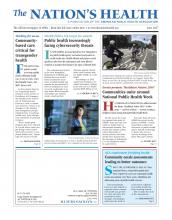Injuries can be much more serious than simply stubbing a toe or cutting a finger. Depending on how severe they are, some injuries have long-term health effects and can lead to disability or earlier death. In fact, injury is the leading cause of death among people ages 1 to 44 in the U.S., according to the Centers for Disease Control and Prevention.
Both big and small injuries happen every day. The good news is that they are largely preventable if you have the right measures in place. Here’s what you can do to prevent three of the most common injuries that affect Americans.
Take steps to prevent falls
Slips and tumbles are common injuries, but there are a number of ways to keep them from happening. Because many falls occur at home, it’s important to remove as many fall risks as possible. Pay close attention to the dangers that could hurt members of your family.
“Most homes were designed to fit the needs of healthy young adults,” says Kristi Lyn Ladowski, MPH, injury prevention and outreach coordinator at Stony Brook Trauma Center.
But such designs can be hazardous for young children, seniors and people with chronic illness or disabilities, she says.
There are plenty of places around the home that can be made safer, and at a low cost. Installing carpeting and non-slip rugs is an easy way to cut down on falls, as well as placing non-slip mats in the shower or bathtub. You and your family can also reduce the risk of falls every day at home by wearing non-slip socks or shoes designed to be worn indoors.
Sometimes, reducing falls begins with examining your health. Balance issues related to aging, illness or a medical condition could make you more likely to fall.
“Typically, it’s not just one reason someone falls; it’s usually a combination of risk factors,” Ladowski says. “It’s important to identify personal risk factors that could lead to a fall and then work on eliminating or reducing those risks when possible.”
Avoid injuries on the road
Whether you’re a driver or passenger, reducing motor vehicle crashes relies on everyone’s cooperation to ensure a safe ride. If you’re behind the wheel, make sure that you’re physically and mentally fit to drive. Drowsy or distracted driving puts everyone in the vehicle and on the road at risk.
CDC groups driving distractions into three categories: those that impair your sight, those that force you to take your hands off the steering wheel and those that make you lose focus. Cellphones can distract you in all these ways and should never be used while driving, even where legal. Hands-free does not necessarily mean risk-free, Ladowski says.
“It’s best to not use your phone at all while driving because it can be a visual, manual and cognitive distraction,” Ladowski says. “If our mind is focused on the phone operation, it’s not focused on driving.”
Talk to the teenage drivers in your family about safe driving habits and make sure they know the rules of the road. That also means being a good role model yourself.
“Parents should demonstrate safe driving behavior at all times,” Ladowski says. “This includes buckling up, not using cellphones, obeying speed limits and coming to a complete stop at stop signs.”
Using child restraints is another way to reduce the risk of injury from motor vehicle crashes. The American Academy of Pediatrics says all children up to 2 years old should be in rear-facing car seats. Kids who have outgrown rear-facing seats should sit in forward-facing car seats with a harness. School-age kids should use a booster seat. Older kids should be buckled up in the back seat.
Make sure household products don’t become poisons
Poisons aren’t just chemicals found in a lab. They can be found all around the home in many different forms. Take household cleaners, for example. These chemicals, including laundry detergent, bleach and all-purpose cleaners, are especially dangerous in the hands of children. Household chemicals are often brightly colored and may look appetizing. Kids may also be tempted to pop poisons like laundry pods into their mouths.
“The saying ‘up and away’ applies to most household poisons,” Ladowski says. “Medications and cleaning supplies, like laundry detergent pods, should be stored high and out of the reach of curious children. These items should always be stored in their original containers, not in food containers like cups and bottles.”
Child safety locks on cabinets where chemicals are stored can provide added protection.

Photo by Onfokus, courtesy iStockphoto
Medications are another poisoning risk. When not taken properly, medications can be harmful, and even deadly. Before you take or give medicine to a member of your family, make sure that you are using the correct one in the correct dose. Medication should always be taken as prescribed by a doctor. If you have any questions about a medication, talk to your health care provider before using it.
- Copyright The Nation’s Health, American Public Health Association









